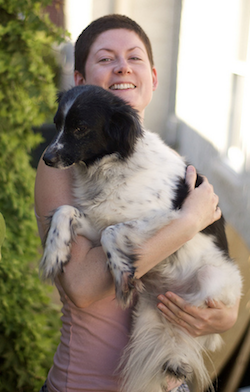 Recently, Petful reader Lorraine F. wrote us with this question:
Recently, Petful reader Lorraine F. wrote us with this question:
“We own a purebred skye terrier named Mollie. She is a lovely 6-year-old girl, but is extremely nervous and seems not to like men. Whenever our friends come to visit, she barks continuously while certain men are in the home. I acquired her at 4 months of age and obviously something lodged in her memory from way back then, because all she gets is loving from my husband. How can I stop this barking?”
Whether you are taking a walk, having a guest over or meeting an old friend, some dogs have such a distaste for men that they become aggressive with them.
The behavior could possibly have something to do with the deep voice, height or posture that men hold.
I see this behavior most commonly in shelter or rescue dogs that have been under-socialized or abused when they were young.
Good News!
The good news is that there are relatively simple training and behavior-modification techniques you can use to eliminate this behavior.
Although there are many reasons that a dog could bark or act aggressively with men, I find that fear is the most common one, followed by the feeling that they need to protect their owner.
No matter the cause of the aggression, the most important thing is to implement leadership techniques.
If fear is the underlying cause of the barking, leadership techniques will help build the dog’s confidence. They will also help the dog understand that he does not need to be fearful because you are in control. If the dog is feeling protective over you, the techniques will show the dog that you do not need to be protected since you are the leader.
The best way to discern the cause of your dog’s barking and aggression is to read his body language.
If the dog is barking out of fear, he is being self-protective and will be leaning away from the feared person or stimulus and have a lowered body stance, with his ears back, hackles up or piloerection, tail tucked, and have a “long mouth.” The long mouth is a snarl that shows all of the dog’s teeth. This is usually a display snarl and is used to scare to the person.
If the underlying cause is the feeling of protectiveness, the body language would be quite different. The dog would be leaning toward the threatening person, tail up and still, hackles up or piloerection, ears forward, and displaying a “short mouth.”
The short mouth snarl shows only the front teeth and is much more threatening than the long mouth. If you are on the receiving end of this behavior and the dog is growling and showing a short mouth, back away — this dog is showing intent to bite.
The treatment plans for dogs that bark at men are different dependent on the underlying cause:
Barking Due to a Fear of Men
If you find yourself in a situation where your dog is barking or being aggressive toward men and you have diagnosed that it’s out of fear, do not freak out and physically correct your dog.
If you physically correct a fearful dog, you can exacerbate the fear or have the dog redirect the aggression onto yourself.
Also, do not try to calm your dog by stroking him or speaking in a sweet tone, as the dog will take this as a reward for the behavior and you will be inadvertently reinforcing the unwanted behavior.
Instead, calmly give a “no reward marker” like “Nope!” and move away from the fearful situation while directing your dog’s attention onto you with a high-value food treat. If your dog is obviously scared, do not allow people to pet him. Overwhelming a fearful dog can cause him to bite.
Was YOUR Pet Food Recalled?
Check Now: Blue Buffalo • Science Diet • Purina • Wellness • 4health • Canine Carry Outs • Friskies • Taste of the Wild • See 200+ more brands…

When adjusting your dog’s fearful behavior, you must work on building his confidence. This is best done through leadership exercises.
Along with leadership training, you also need to set aside some time to train your dog not be fearful of men. During training, you need to desensitize your dog by finding his “threshold of tolerance,” or the location where your dog notices the fearful stimulus but does not react.
Praise and reward your dog for not reacting to men and continue at the same distance for about two weeks. On the third week, go a little closer to the stimulus but not close enough that the dog reacts aggressively, then praise and reward.
Continue this process for as long as it takes for the dog to be comfortable being closer to men.
A good place to work on desensitizing your dog is — wait for it — Home Depot. Yes, at Home Depot there are tons of men, and Home Depot allows dogs in their store. Once your dog has become less sensitive to men, you can hire a male to walk your dog or a male relative to offer food to help establish a positive association with men.
Aggression Due to a Need to Protect
Once you have found that your dog is being aggressive or barking at men because your dog is being protective, and you are in a situation where your dog is acting like this, move away from the threatening person.
You put yourself in great danger if you physically correct a dog like this — often the aggression will redirect itself toward you.
The most important thing to do if you have a dog like this is to implement leadership techniques.
Understand that the dog is showing you that for some reason you need to be protected. You must assert yourself as the leader and show the dog that you are in no need of protection.
Dogs will feel that they need to take control of a situation if they feel their owner cannot.
When you are communicating to the dog that you do not need to be protected, I suggest purchasing the [easyazon_link asin=”B0051GO5WM” locale=”US” new_window=”default” nofollow=”default” tag=”p51capital07-20″ add_to_cart=”default” cloaking=”default” localization=”default” popups=”default”]Pet Corrector[/easyazon_link]. This is a can of compressed air that when emitted makes a loud, startling sound.
As soon as the dog begins to show protective body language, say, “No!” and spray for a split second toward the dog (not at the dog.)
For better control over an aggressive dog, use a head collar, such as a Halti.
Once you have interrupted the behavior, give a tug on the head collar or collar to get the dog’s attention, and reward him for looking at you. Continue to communicate to your dog that you do not need to be protected and that the behavior he is displaying is unwarranted.
Aggression With a Guest
Another common issue is a dog being aggressive with a guest that comes to your house.
In this situation, I highly suggest getting your dog into a good training program to teach “heel” and “down.” Once you have a solid “heel” and “down,” you must always leash your dog in the house when a guest is over. When a guest enters, tell him or her not to pay attention to the dog at all, not to even look at the dog.
While the dog is in a “heel,” sit down with the guest and have the dog sit at your feet.
Once he is calm, give him a high-value chew toy or a filled KONG. Save the really good treats for when guests are over, so the dog begins to associate guests with a high-value reward. If the dog begins to bark or act up, calmly say “no” and redirect the dog’s attention.
Aggression toward men, no matter what the cause, can be dealt with through positive reward training. Stay calm and remain patient with the dog, and remember that he is displaying the behavior for a reason.
Communicate with him that you are in control and he doesn’t need to bark or be aggressive with strangers.
Bottom two photos: smerikal and jbachman01/Flickr



